The Own-Race Bias Effect and the Effects of Happy Facial Expressions during Face Recognition
VerifiedAdded on 2023/06/10
|12
|2401
|167
AI Summary
This study explores the own-race bias effect and the effects of happy facial expressions during face recognition. The study aims to generalize the own-race bias effects in Singapore and demonstrate the effects of facial expression on the own-race bias effect. The study used an experimental model and the Signal Detection Theory to measure memory recognition. The results showed that the neutral faces of the Asians were remembered better than the happy faces.
Contribute Materials
Your contribution can guide someone’s learning journey. Share your
documents today.
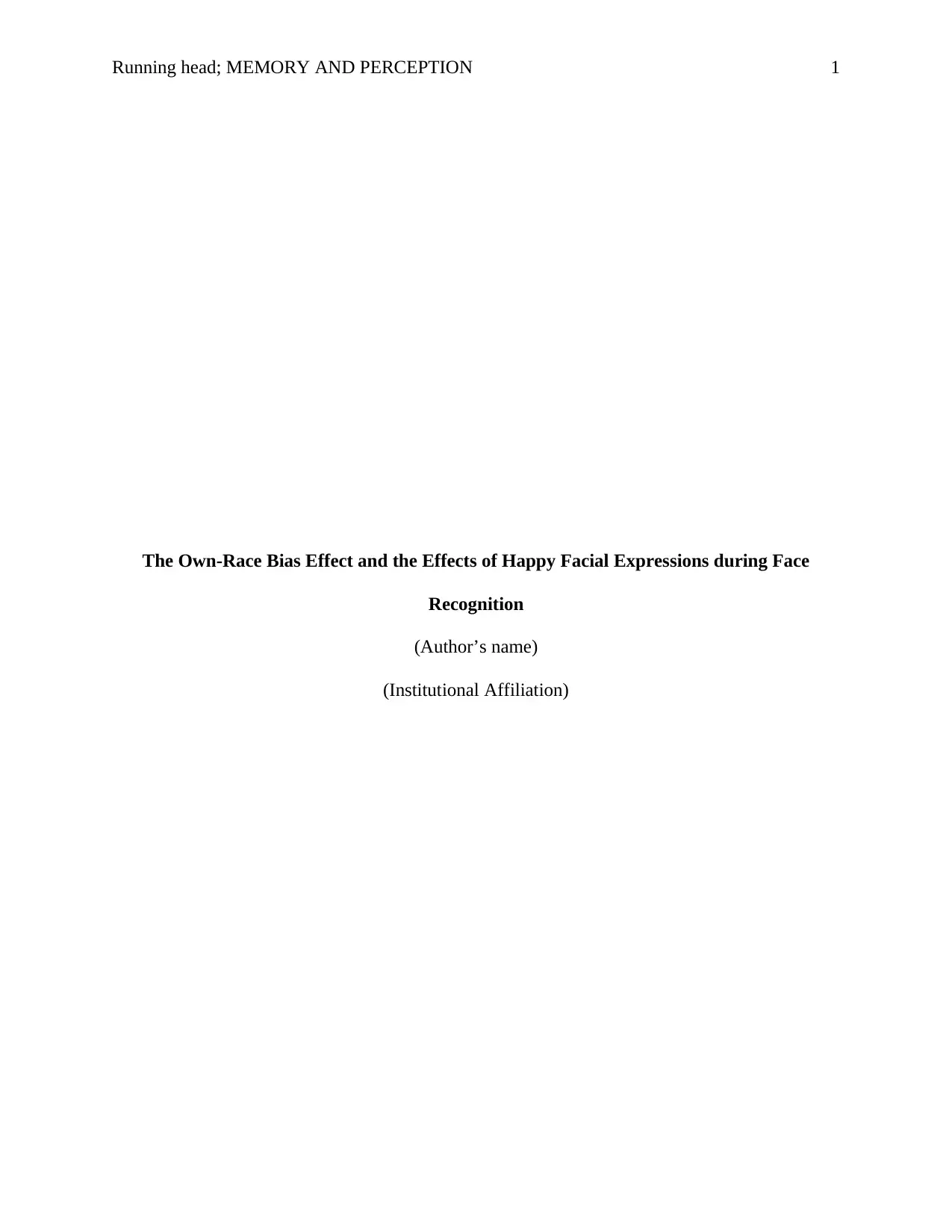
Running head; MEMORY AND PERCEPTION 1
The Own-Race Bias Effect and the Effects of Happy Facial Expressions during Face
Recognition
(Author’s name)
(Institutional Affiliation)
The Own-Race Bias Effect and the Effects of Happy Facial Expressions during Face
Recognition
(Author’s name)
(Institutional Affiliation)
Secure Best Marks with AI Grader
Need help grading? Try our AI Grader for instant feedback on your assignments.
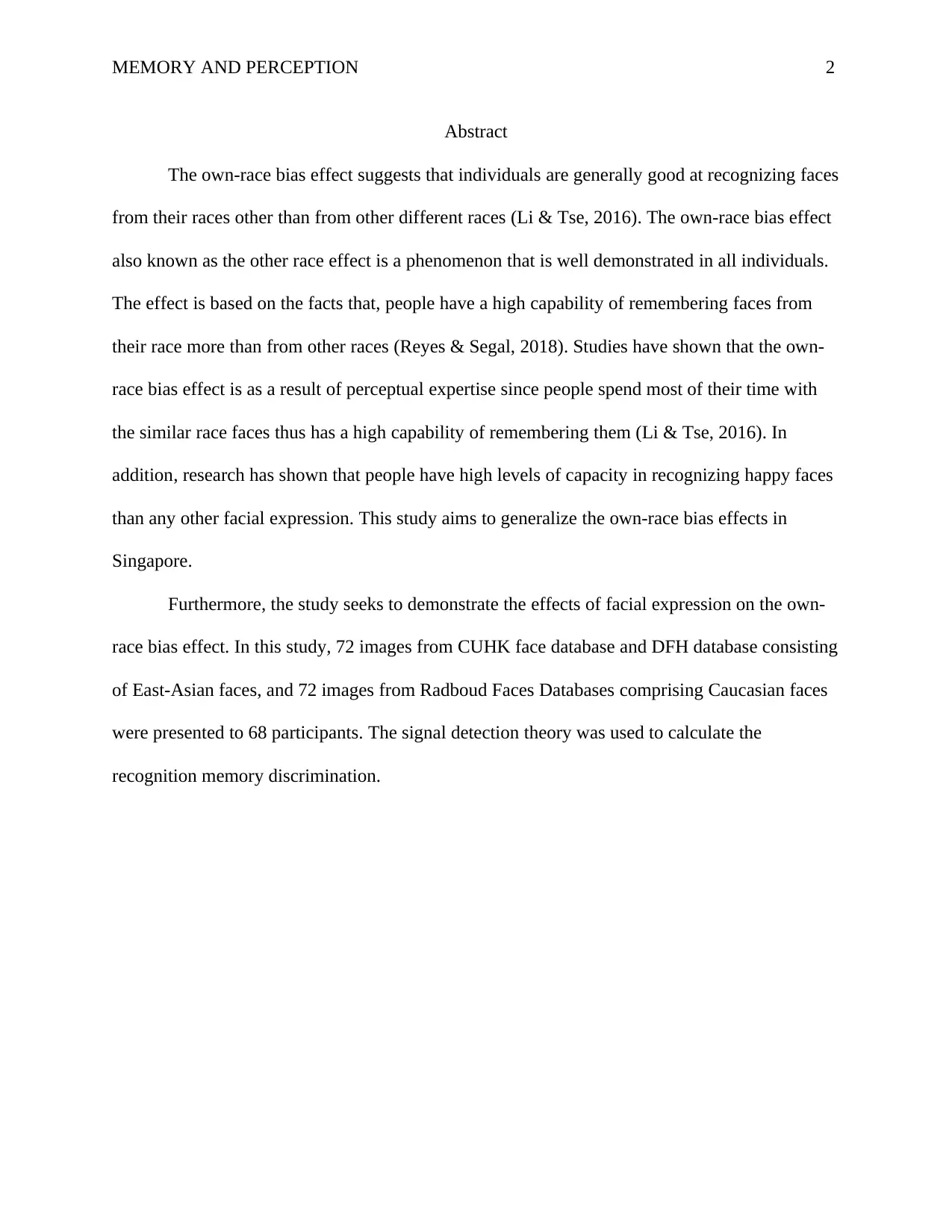
MEMORY AND PERCEPTION 2
Abstract
The own-race bias effect suggests that individuals are generally good at recognizing faces
from their races other than from other different races (Li & Tse, 2016). The own-race bias effect
also known as the other race effect is a phenomenon that is well demonstrated in all individuals.
The effect is based on the facts that, people have a high capability of remembering faces from
their race more than from other races (Reyes & Segal, 2018). Studies have shown that the own-
race bias effect is as a result of perceptual expertise since people spend most of their time with
the similar race faces thus has a high capability of remembering them (Li & Tse, 2016). In
addition, research has shown that people have high levels of capacity in recognizing happy faces
than any other facial expression. This study aims to generalize the own-race bias effects in
Singapore.
Furthermore, the study seeks to demonstrate the effects of facial expression on the own-
race bias effect. In this study, 72 images from CUHK face database and DFH database consisting
of East-Asian faces, and 72 images from Radboud Faces Databases comprising Caucasian faces
were presented to 68 participants. The signal detection theory was used to calculate the
recognition memory discrimination.
Abstract
The own-race bias effect suggests that individuals are generally good at recognizing faces
from their races other than from other different races (Li & Tse, 2016). The own-race bias effect
also known as the other race effect is a phenomenon that is well demonstrated in all individuals.
The effect is based on the facts that, people have a high capability of remembering faces from
their race more than from other races (Reyes & Segal, 2018). Studies have shown that the own-
race bias effect is as a result of perceptual expertise since people spend most of their time with
the similar race faces thus has a high capability of remembering them (Li & Tse, 2016). In
addition, research has shown that people have high levels of capacity in recognizing happy faces
than any other facial expression. This study aims to generalize the own-race bias effects in
Singapore.
Furthermore, the study seeks to demonstrate the effects of facial expression on the own-
race bias effect. In this study, 72 images from CUHK face database and DFH database consisting
of East-Asian faces, and 72 images from Radboud Faces Databases comprising Caucasian faces
were presented to 68 participants. The signal detection theory was used to calculate the
recognition memory discrimination.
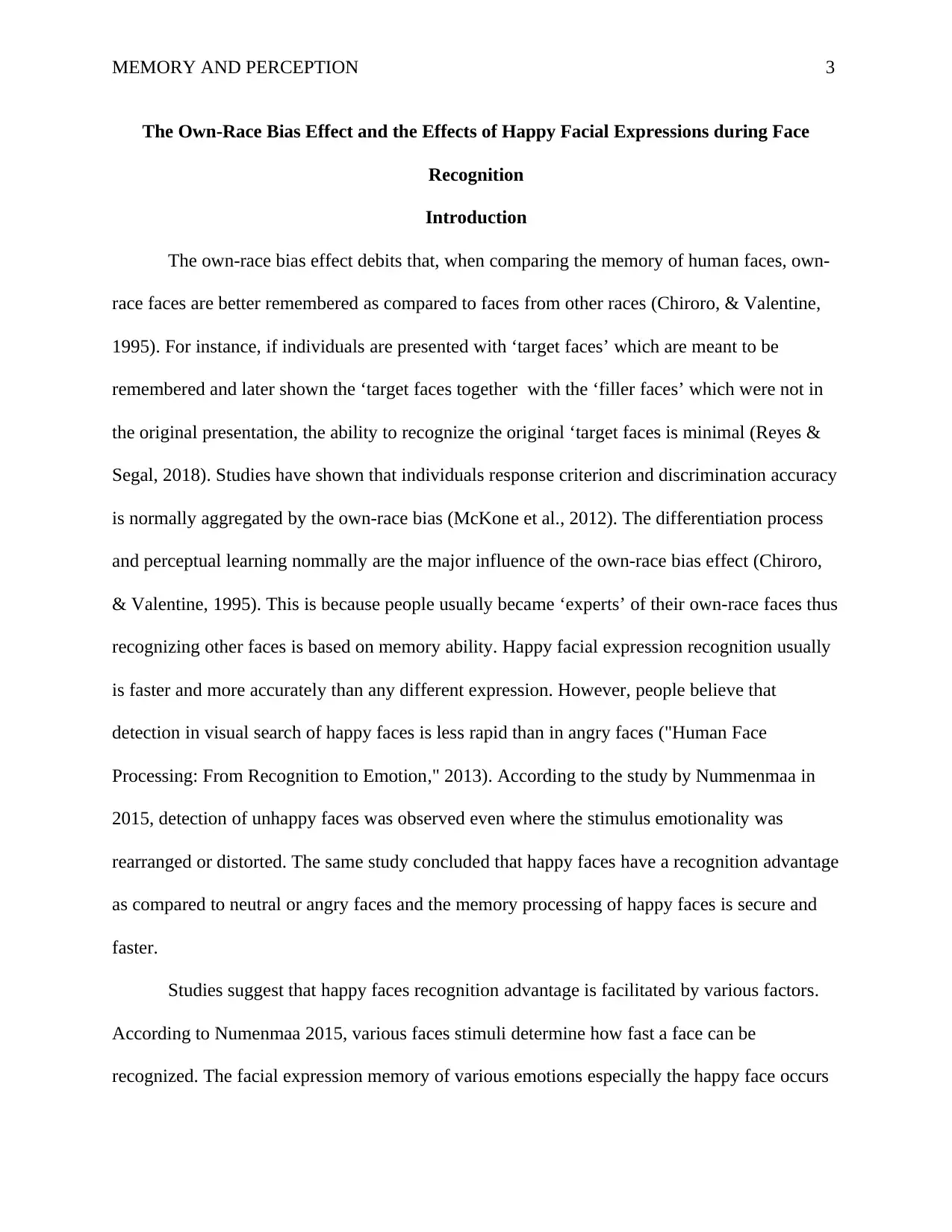
MEMORY AND PERCEPTION 3
The Own-Race Bias Effect and the Effects of Happy Facial Expressions during Face
Recognition
Introduction
The own-race bias effect debits that, when comparing the memory of human faces, own-
race faces are better remembered as compared to faces from other races (Chiroro, & Valentine,
1995). For instance, if individuals are presented with ‘target faces’ which are meant to be
remembered and later shown the ‘target faces together with the ‘filler faces’ which were not in
the original presentation, the ability to recognize the original ‘target faces is minimal (Reyes &
Segal, 2018). Studies have shown that individuals response criterion and discrimination accuracy
is normally aggregated by the own-race bias (McKone et al., 2012). The differentiation process
and perceptual learning nommally are the major influence of the own-race bias effect (Chiroro,
& Valentine, 1995). This is because people usually became ‘experts’ of their own-race faces thus
recognizing other faces is based on memory ability. Happy facial expression recognition usually
is faster and more accurately than any different expression. However, people believe that
detection in visual search of happy faces is less rapid than in angry faces ("Human Face
Processing: From Recognition to Emotion," 2013). According to the study by Nummenmaa in
2015, detection of unhappy faces was observed even where the stimulus emotionality was
rearranged or distorted. The same study concluded that happy faces have a recognition advantage
as compared to neutral or angry faces and the memory processing of happy faces is secure and
faster.
Studies suggest that happy faces recognition advantage is facilitated by various factors.
According to Numenmaa 2015, various faces stimuli determine how fast a face can be
recognized. The facial expression memory of various emotions especially the happy face occurs
The Own-Race Bias Effect and the Effects of Happy Facial Expressions during Face
Recognition
Introduction
The own-race bias effect debits that, when comparing the memory of human faces, own-
race faces are better remembered as compared to faces from other races (Chiroro, & Valentine,
1995). For instance, if individuals are presented with ‘target faces’ which are meant to be
remembered and later shown the ‘target faces together with the ‘filler faces’ which were not in
the original presentation, the ability to recognize the original ‘target faces is minimal (Reyes &
Segal, 2018). Studies have shown that individuals response criterion and discrimination accuracy
is normally aggregated by the own-race bias (McKone et al., 2012). The differentiation process
and perceptual learning nommally are the major influence of the own-race bias effect (Chiroro,
& Valentine, 1995). This is because people usually became ‘experts’ of their own-race faces thus
recognizing other faces is based on memory ability. Happy facial expression recognition usually
is faster and more accurately than any different expression. However, people believe that
detection in visual search of happy faces is less rapid than in angry faces ("Human Face
Processing: From Recognition to Emotion," 2013). According to the study by Nummenmaa in
2015, detection of unhappy faces was observed even where the stimulus emotionality was
rearranged or distorted. The same study concluded that happy faces have a recognition advantage
as compared to neutral or angry faces and the memory processing of happy faces is secure and
faster.
Studies suggest that happy faces recognition advantage is facilitated by various factors.
According to Numenmaa 2015, various faces stimuli determine how fast a face can be
recognized. The facial expression memory of various emotions especially the happy face occurs
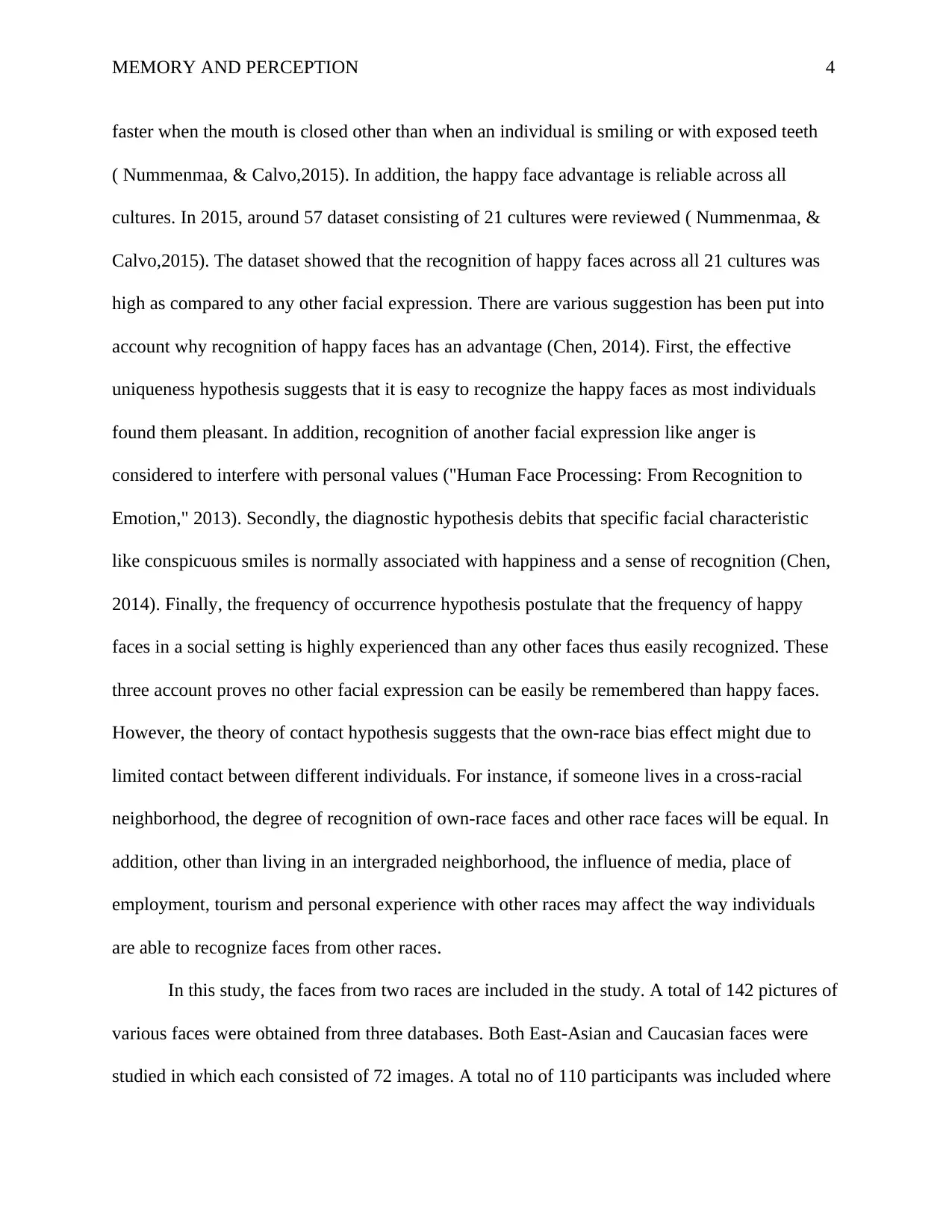
MEMORY AND PERCEPTION 4
faster when the mouth is closed other than when an individual is smiling or with exposed teeth
( Nummenmaa, & Calvo,2015). In addition, the happy face advantage is reliable across all
cultures. In 2015, around 57 dataset consisting of 21 cultures were reviewed ( Nummenmaa, &
Calvo,2015). The dataset showed that the recognition of happy faces across all 21 cultures was
high as compared to any other facial expression. There are various suggestion has been put into
account why recognition of happy faces has an advantage (Chen, 2014). First, the effective
uniqueness hypothesis suggests that it is easy to recognize the happy faces as most individuals
found them pleasant. In addition, recognition of another facial expression like anger is
considered to interfere with personal values ("Human Face Processing: From Recognition to
Emotion," 2013). Secondly, the diagnostic hypothesis debits that specific facial characteristic
like conspicuous smiles is normally associated with happiness and a sense of recognition (Chen,
2014). Finally, the frequency of occurrence hypothesis postulate that the frequency of happy
faces in a social setting is highly experienced than any other faces thus easily recognized. These
three account proves no other facial expression can be easily be remembered than happy faces.
However, the theory of contact hypothesis suggests that the own-race bias effect might due to
limited contact between different individuals. For instance, if someone lives in a cross-racial
neighborhood, the degree of recognition of own-race faces and other race faces will be equal. In
addition, other than living in an intergraded neighborhood, the influence of media, place of
employment, tourism and personal experience with other races may affect the way individuals
are able to recognize faces from other races.
In this study, the faces from two races are included in the study. A total of 142 pictures of
various faces were obtained from three databases. Both East-Asian and Caucasian faces were
studied in which each consisted of 72 images. A total no of 110 participants was included where
faster when the mouth is closed other than when an individual is smiling or with exposed teeth
( Nummenmaa, & Calvo,2015). In addition, the happy face advantage is reliable across all
cultures. In 2015, around 57 dataset consisting of 21 cultures were reviewed ( Nummenmaa, &
Calvo,2015). The dataset showed that the recognition of happy faces across all 21 cultures was
high as compared to any other facial expression. There are various suggestion has been put into
account why recognition of happy faces has an advantage (Chen, 2014). First, the effective
uniqueness hypothesis suggests that it is easy to recognize the happy faces as most individuals
found them pleasant. In addition, recognition of another facial expression like anger is
considered to interfere with personal values ("Human Face Processing: From Recognition to
Emotion," 2013). Secondly, the diagnostic hypothesis debits that specific facial characteristic
like conspicuous smiles is normally associated with happiness and a sense of recognition (Chen,
2014). Finally, the frequency of occurrence hypothesis postulate that the frequency of happy
faces in a social setting is highly experienced than any other faces thus easily recognized. These
three account proves no other facial expression can be easily be remembered than happy faces.
However, the theory of contact hypothesis suggests that the own-race bias effect might due to
limited contact between different individuals. For instance, if someone lives in a cross-racial
neighborhood, the degree of recognition of own-race faces and other race faces will be equal. In
addition, other than living in an intergraded neighborhood, the influence of media, place of
employment, tourism and personal experience with other races may affect the way individuals
are able to recognize faces from other races.
In this study, the faces from two races are included in the study. A total of 142 pictures of
various faces were obtained from three databases. Both East-Asian and Caucasian faces were
studied in which each consisted of 72 images. A total no of 110 participants was included where
Secure Best Marks with AI Grader
Need help grading? Try our AI Grader for instant feedback on your assignments.
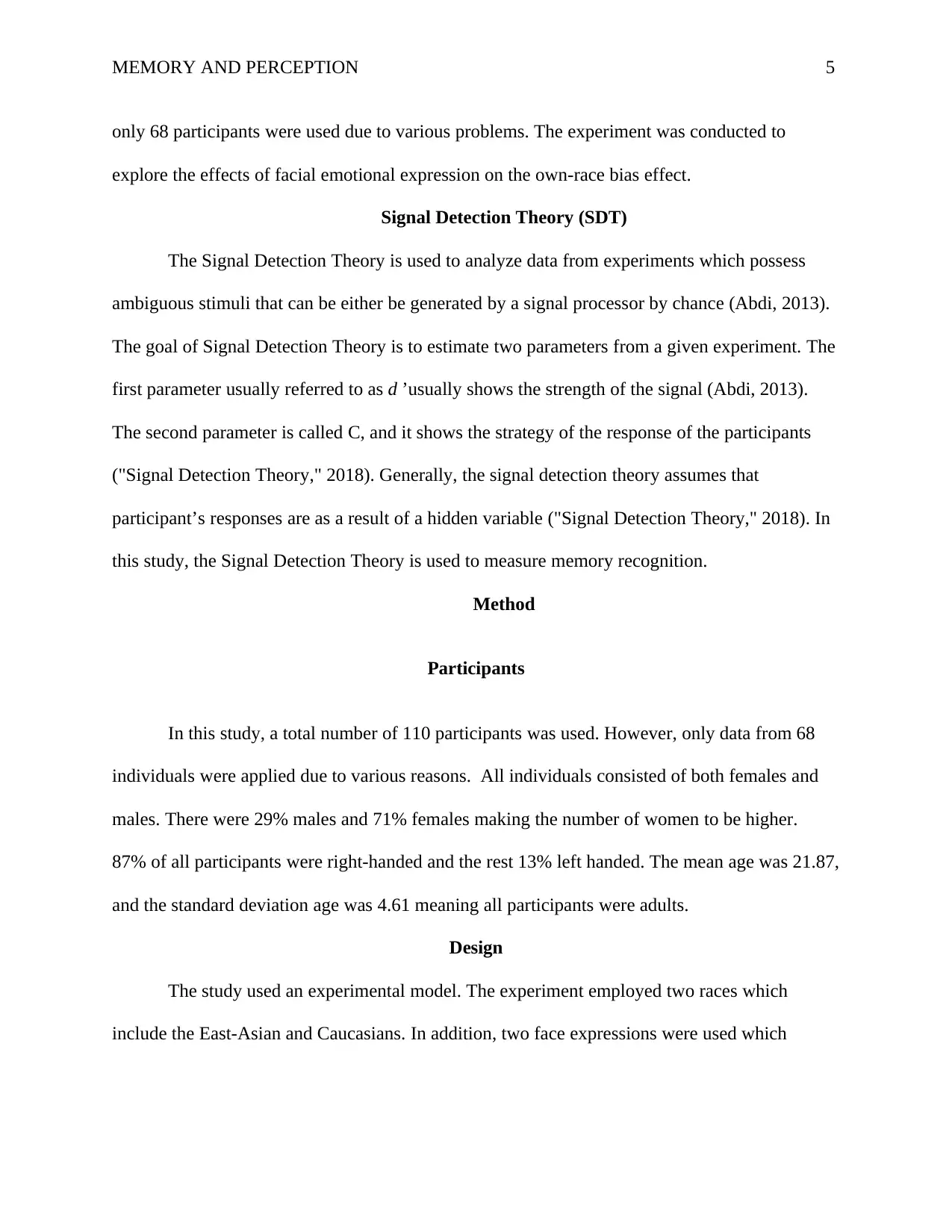
MEMORY AND PERCEPTION 5
only 68 participants were used due to various problems. The experiment was conducted to
explore the effects of facial emotional expression on the own-race bias effect.
Signal Detection Theory (SDT)
The Signal Detection Theory is used to analyze data from experiments which possess
ambiguous stimuli that can be either be generated by a signal processor by chance (Abdi, 2013).
The goal of Signal Detection Theory is to estimate two parameters from a given experiment. The
first parameter usually referred to as d ’usually shows the strength of the signal (Abdi, 2013).
The second parameter is called C, and it shows the strategy of the response of the participants
("Signal Detection Theory," 2018). Generally, the signal detection theory assumes that
participant’s responses are as a result of a hidden variable ("Signal Detection Theory," 2018). In
this study, the Signal Detection Theory is used to measure memory recognition.
Method
Participants
In this study, a total number of 110 participants was used. However, only data from 68
individuals were applied due to various reasons. All individuals consisted of both females and
males. There were 29% males and 71% females making the number of women to be higher.
87% of all participants were right-handed and the rest 13% left handed. The mean age was 21.87,
and the standard deviation age was 4.61 meaning all participants were adults.
Design
The study used an experimental model. The experiment employed two races which
include the East-Asian and Caucasians. In addition, two face expressions were used which
only 68 participants were used due to various problems. The experiment was conducted to
explore the effects of facial emotional expression on the own-race bias effect.
Signal Detection Theory (SDT)
The Signal Detection Theory is used to analyze data from experiments which possess
ambiguous stimuli that can be either be generated by a signal processor by chance (Abdi, 2013).
The goal of Signal Detection Theory is to estimate two parameters from a given experiment. The
first parameter usually referred to as d ’usually shows the strength of the signal (Abdi, 2013).
The second parameter is called C, and it shows the strategy of the response of the participants
("Signal Detection Theory," 2018). Generally, the signal detection theory assumes that
participant’s responses are as a result of a hidden variable ("Signal Detection Theory," 2018). In
this study, the Signal Detection Theory is used to measure memory recognition.
Method
Participants
In this study, a total number of 110 participants was used. However, only data from 68
individuals were applied due to various reasons. All individuals consisted of both females and
males. There were 29% males and 71% females making the number of women to be higher.
87% of all participants were right-handed and the rest 13% left handed. The mean age was 21.87,
and the standard deviation age was 4.61 meaning all participants were adults.
Design
The study used an experimental model. The experiment employed two races which
include the East-Asian and Caucasians. In addition, two face expressions were used which

MEMORY AND PERCEPTION 6
include happy and neutral faces. The experimental design applied sigmoid detection theory to
calculate memory discrimination (d’) which was used as the DV.
Materials
A total number of 72 East-Asian faces images were obtained from both the CUHK Face
Database and DFH Database. A total number of 36 pictures from this category were portraited
neutral-emotion faces, and the other 36 images were happy emotion faces. Half of the
photographs showed female, and the other half showed males of both types. All photos were of
high quality measuring 16” by 20” print and a resolution of 1600 by 1200 pixels. The second
group consisted of 72 Caucasian faces images selected from Radboud Faces Database. Thirty-six
of the images were portrayed-neutral emotion faces and the other half happy faces. Half of the
pictures showed male and the other half females. The quality and size of the pictures was similar
as of the East-Asian faces images.
Procedure
The procedure was programmed with E-prime 2.0. During the study, the images in both
groups were divided into two major trial sessions conducted over five days. Each session took
two days with three rounds of presentations. During the first day, a total number of 24 images
was presented from both East-Asia faces and Caucasian faces. The participants were presented
with both six happy, and six neutral East-Asian male and females face images in the first round.
The participants were later presented with both six happy and six neutral Caucasian faces images
in the second round. The participants were left to rest until the second day where all first and
second round images were represented again together with the additional six happy and six
neutral new East Asia female and male face images and six happy and six neutral new Caucasian
include happy and neutral faces. The experimental design applied sigmoid detection theory to
calculate memory discrimination (d’) which was used as the DV.
Materials
A total number of 72 East-Asian faces images were obtained from both the CUHK Face
Database and DFH Database. A total number of 36 pictures from this category were portraited
neutral-emotion faces, and the other 36 images were happy emotion faces. Half of the
photographs showed female, and the other half showed males of both types. All photos were of
high quality measuring 16” by 20” print and a resolution of 1600 by 1200 pixels. The second
group consisted of 72 Caucasian faces images selected from Radboud Faces Database. Thirty-six
of the images were portrayed-neutral emotion faces and the other half happy faces. Half of the
pictures showed male and the other half females. The quality and size of the pictures was similar
as of the East-Asian faces images.
Procedure
The procedure was programmed with E-prime 2.0. During the study, the images in both
groups were divided into two major trial sessions conducted over five days. Each session took
two days with three rounds of presentations. During the first day, a total number of 24 images
was presented from both East-Asia faces and Caucasian faces. The participants were presented
with both six happy, and six neutral East-Asian male and females face images in the first round.
The participants were later presented with both six happy and six neutral Caucasian faces images
in the second round. The participants were left to rest until the second day where all first and
second round images were represented again together with the additional six happy and six
neutral new East Asia female and male face images and six happy and six neutral new Caucasian

MEMORY AND PERCEPTION 7
male and female face images. The participants were asked to recognize the first 24 pictures
where the data were reconded. The procedure was repeated during the second session on the
third and fourth day, and the fifth day the results were compiled.
male and female face images. The participants were asked to recognize the first 24 pictures
where the data were reconded. The procedure was repeated during the second session on the
third and fourth day, and the fifth day the results were compiled.
Paraphrase This Document
Need a fresh take? Get an instant paraphrase of this document with our AI Paraphraser
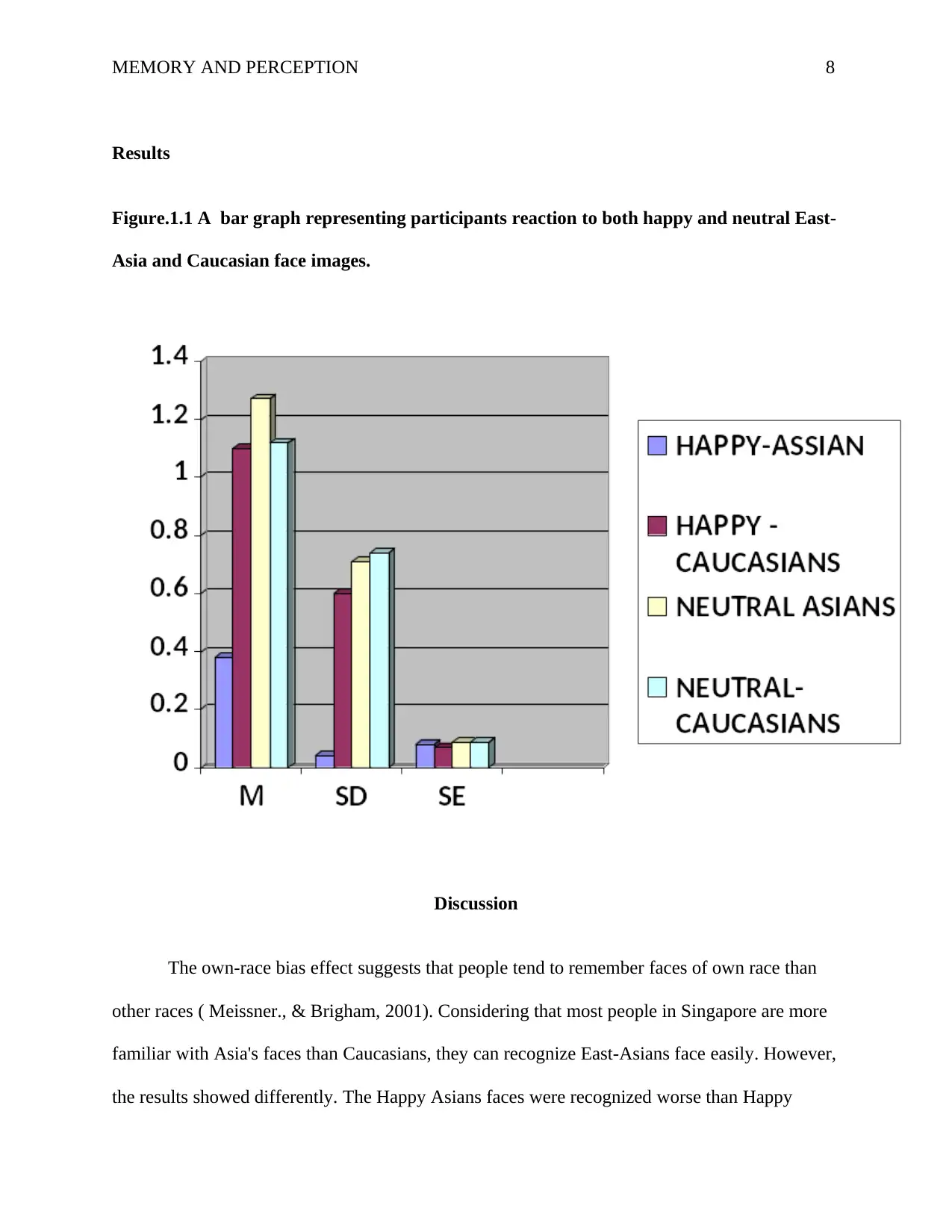
MEMORY AND PERCEPTION 8
Results
Figure.1.1 A bar graph representing participants reaction to both happy and neutral East-
Asia and Caucasian face images.
Discussion
The own-race bias effect suggests that people tend to remember faces of own race than
other races ( Meissner., & Brigham, 2001). Considering that most people in Singapore are more
familiar with Asia's faces than Caucasians, they can recognize East-Asians face easily. However,
the results showed differently. The Happy Asians faces were recognized worse than Happy
Results
Figure.1.1 A bar graph representing participants reaction to both happy and neutral East-
Asia and Caucasian face images.
Discussion
The own-race bias effect suggests that people tend to remember faces of own race than
other races ( Meissner., & Brigham, 2001). Considering that most people in Singapore are more
familiar with Asia's faces than Caucasians, they can recognize East-Asians face easily. However,
the results showed differently. The Happy Asians faces were recognized worse than Happy
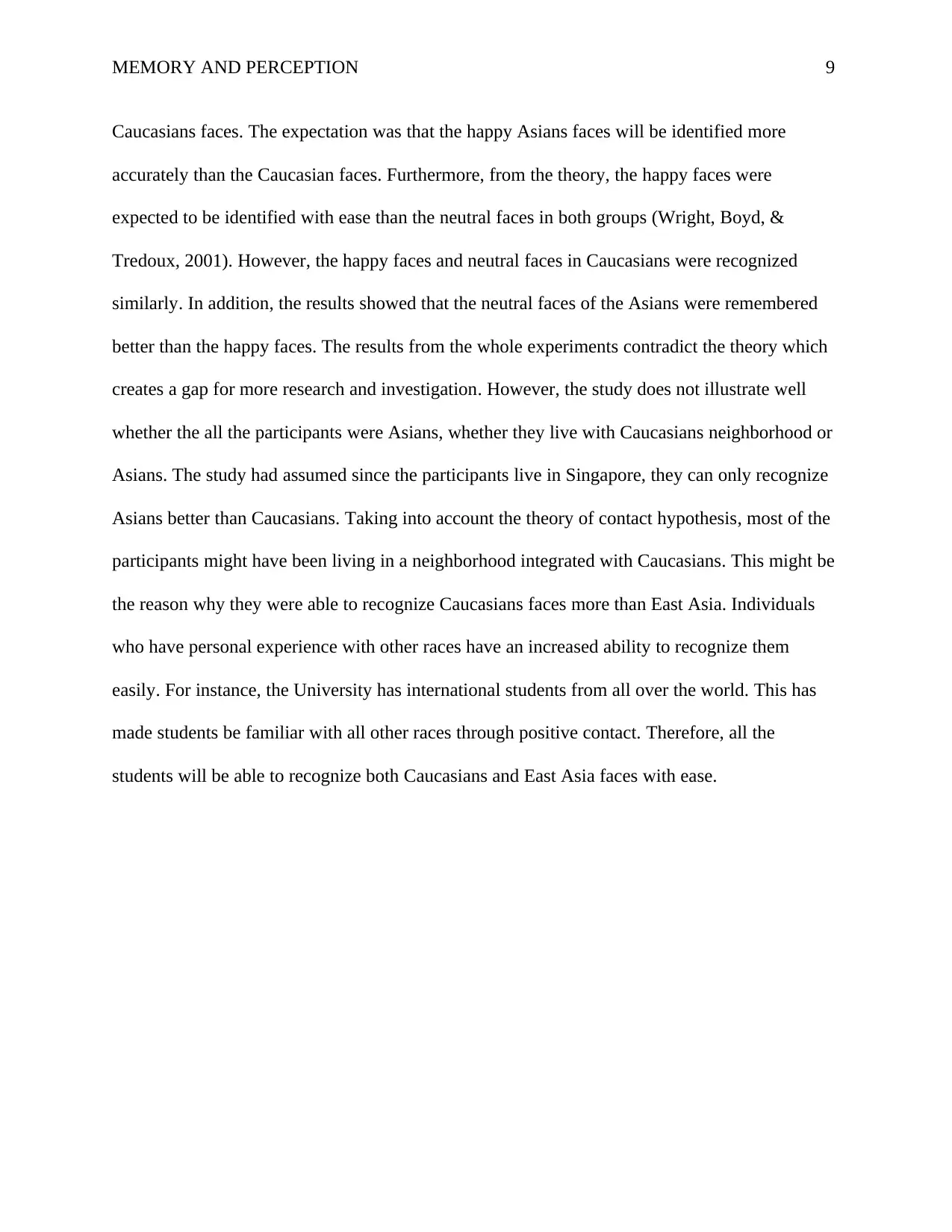
MEMORY AND PERCEPTION 9
Caucasians faces. The expectation was that the happy Asians faces will be identified more
accurately than the Caucasian faces. Furthermore, from the theory, the happy faces were
expected to be identified with ease than the neutral faces in both groups (Wright, Boyd, &
Tredoux, 2001). However, the happy faces and neutral faces in Caucasians were recognized
similarly. In addition, the results showed that the neutral faces of the Asians were remembered
better than the happy faces. The results from the whole experiments contradict the theory which
creates a gap for more research and investigation. However, the study does not illustrate well
whether the all the participants were Asians, whether they live with Caucasians neighborhood or
Asians. The study had assumed since the participants live in Singapore, they can only recognize
Asians better than Caucasians. Taking into account the theory of contact hypothesis, most of the
participants might have been living in a neighborhood integrated with Caucasians. This might be
the reason why they were able to recognize Caucasians faces more than East Asia. Individuals
who have personal experience with other races have an increased ability to recognize them
easily. For instance, the University has international students from all over the world. This has
made students be familiar with all other races through positive contact. Therefore, all the
students will be able to recognize both Caucasians and East Asia faces with ease.
Caucasians faces. The expectation was that the happy Asians faces will be identified more
accurately than the Caucasian faces. Furthermore, from the theory, the happy faces were
expected to be identified with ease than the neutral faces in both groups (Wright, Boyd, &
Tredoux, 2001). However, the happy faces and neutral faces in Caucasians were recognized
similarly. In addition, the results showed that the neutral faces of the Asians were remembered
better than the happy faces. The results from the whole experiments contradict the theory which
creates a gap for more research and investigation. However, the study does not illustrate well
whether the all the participants were Asians, whether they live with Caucasians neighborhood or
Asians. The study had assumed since the participants live in Singapore, they can only recognize
Asians better than Caucasians. Taking into account the theory of contact hypothesis, most of the
participants might have been living in a neighborhood integrated with Caucasians. This might be
the reason why they were able to recognize Caucasians faces more than East Asia. Individuals
who have personal experience with other races have an increased ability to recognize them
easily. For instance, the University has international students from all over the world. This has
made students be familiar with all other races through positive contact. Therefore, all the
students will be able to recognize both Caucasians and East Asia faces with ease.
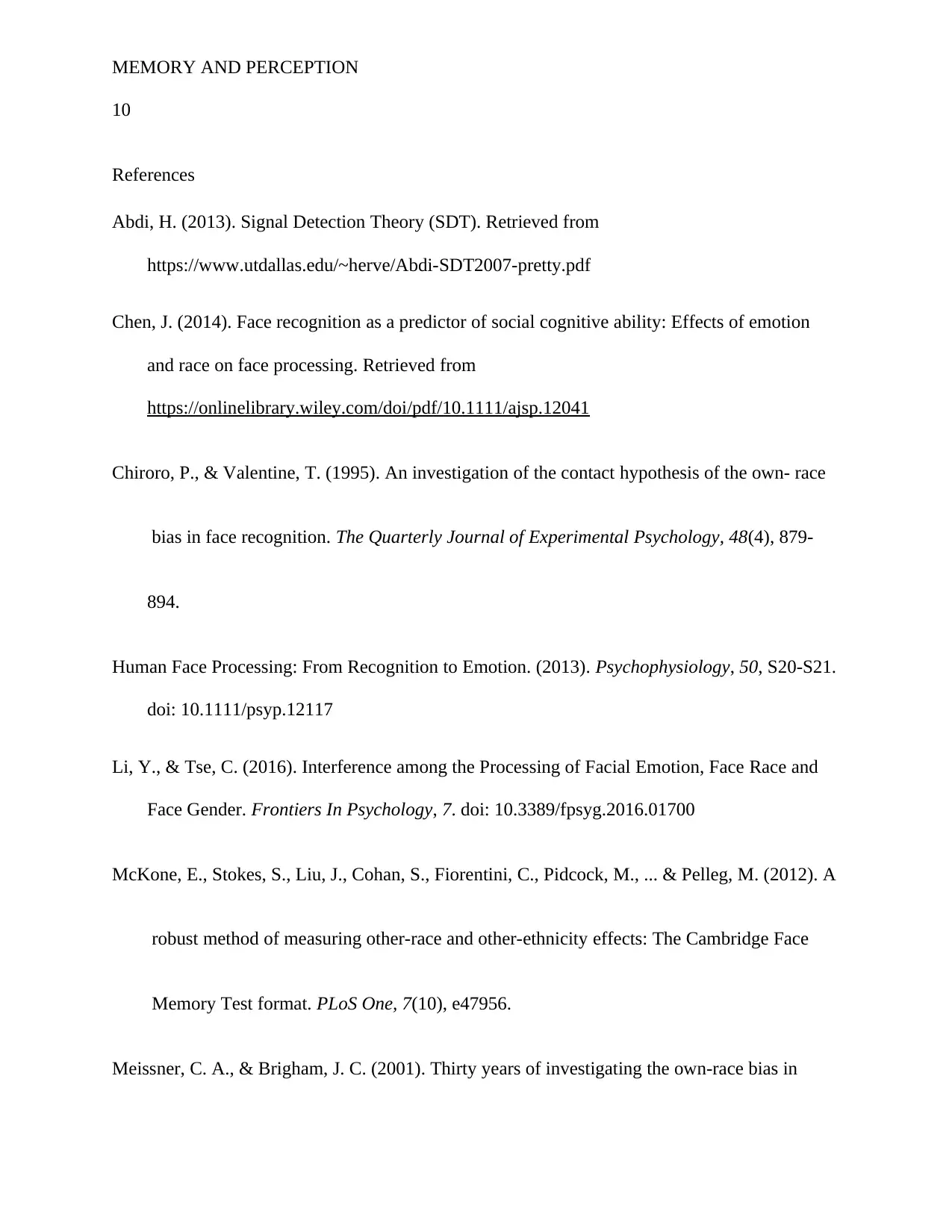
MEMORY AND PERCEPTION
10
References
Abdi, H. (2013). Signal Detection Theory (SDT). Retrieved from
https://www.utdallas.edu/~herve/Abdi-SDT2007-pretty.pdf
Chen, J. (2014). Face recognition as a predictor of social cognitive ability: Effects of emotion
and race on face processing. Retrieved from
https://onlinelibrary.wiley.com/doi/pdf/10.1111/ajsp.12041
Chiroro, P., & Valentine, T. (1995). An investigation of the contact hypothesis of the own- race
bias in face recognition. The Quarterly Journal of Experimental Psychology, 48(4), 879-
894.
Human Face Processing: From Recognition to Emotion. (2013). Psychophysiology, 50, S20-S21.
doi: 10.1111/psyp.12117
Li, Y., & Tse, C. (2016). Interference among the Processing of Facial Emotion, Face Race and
Face Gender. Frontiers In Psychology, 7. doi: 10.3389/fpsyg.2016.01700
McKone, E., Stokes, S., Liu, J., Cohan, S., Fiorentini, C., Pidcock, M., ... & Pelleg, M. (2012). A
robust method of measuring other-race and other-ethnicity effects: The Cambridge Face
Memory Test format. PLoS One, 7(10), e47956.
Meissner, C. A., & Brigham, J. C. (2001). Thirty years of investigating the own-race bias in
10
References
Abdi, H. (2013). Signal Detection Theory (SDT). Retrieved from
https://www.utdallas.edu/~herve/Abdi-SDT2007-pretty.pdf
Chen, J. (2014). Face recognition as a predictor of social cognitive ability: Effects of emotion
and race on face processing. Retrieved from
https://onlinelibrary.wiley.com/doi/pdf/10.1111/ajsp.12041
Chiroro, P., & Valentine, T. (1995). An investigation of the contact hypothesis of the own- race
bias in face recognition. The Quarterly Journal of Experimental Psychology, 48(4), 879-
894.
Human Face Processing: From Recognition to Emotion. (2013). Psychophysiology, 50, S20-S21.
doi: 10.1111/psyp.12117
Li, Y., & Tse, C. (2016). Interference among the Processing of Facial Emotion, Face Race and
Face Gender. Frontiers In Psychology, 7. doi: 10.3389/fpsyg.2016.01700
McKone, E., Stokes, S., Liu, J., Cohan, S., Fiorentini, C., Pidcock, M., ... & Pelleg, M. (2012). A
robust method of measuring other-race and other-ethnicity effects: The Cambridge Face
Memory Test format. PLoS One, 7(10), e47956.
Meissner, C. A., & Brigham, J. C. (2001). Thirty years of investigating the own-race bias in
Secure Best Marks with AI Grader
Need help grading? Try our AI Grader for instant feedback on your assignments.
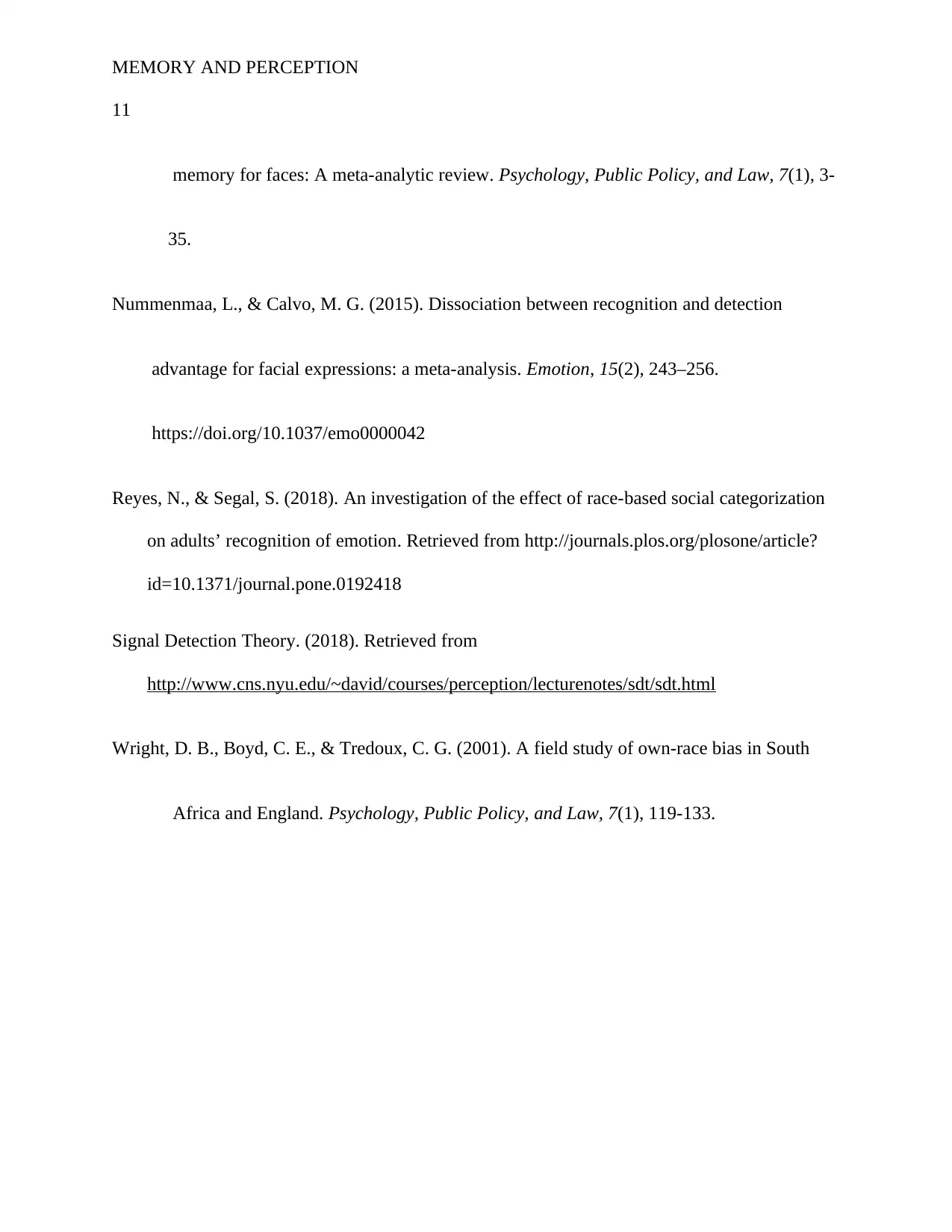
MEMORY AND PERCEPTION
11
memory for faces: A meta-analytic review. Psychology, Public Policy, and Law, 7(1), 3-
35.
Nummenmaa, L., & Calvo, M. G. (2015). Dissociation between recognition and detection
advantage for facial expressions: a meta-analysis. Emotion, 15(2), 243–256.
https://doi.org/10.1037/emo0000042
Reyes, N., & Segal, S. (2018). An investigation of the effect of race-based social categorization
on adults’ recognition of emotion. Retrieved from http://journals.plos.org/plosone/article?
id=10.1371/journal.pone.0192418
Signal Detection Theory. (2018). Retrieved from
http://www.cns.nyu.edu/~david/courses/perception/lecturenotes/sdt/sdt.html
Wright, D. B., Boyd, C. E., & Tredoux, C. G. (2001). A field study of own-race bias in South
Africa and England. Psychology, Public Policy, and Law, 7(1), 119-133.
11
memory for faces: A meta-analytic review. Psychology, Public Policy, and Law, 7(1), 3-
35.
Nummenmaa, L., & Calvo, M. G. (2015). Dissociation between recognition and detection
advantage for facial expressions: a meta-analysis. Emotion, 15(2), 243–256.
https://doi.org/10.1037/emo0000042
Reyes, N., & Segal, S. (2018). An investigation of the effect of race-based social categorization
on adults’ recognition of emotion. Retrieved from http://journals.plos.org/plosone/article?
id=10.1371/journal.pone.0192418
Signal Detection Theory. (2018). Retrieved from
http://www.cns.nyu.edu/~david/courses/perception/lecturenotes/sdt/sdt.html
Wright, D. B., Boyd, C. E., & Tredoux, C. G. (2001). A field study of own-race bias in South
Africa and England. Psychology, Public Policy, and Law, 7(1), 119-133.

MEMORY AND PERCEPTION
12
12
1 out of 12
Your All-in-One AI-Powered Toolkit for Academic Success.
+13062052269
info@desklib.com
Available 24*7 on WhatsApp / Email
![[object Object]](/_next/static/media/star-bottom.7253800d.svg)
Unlock your academic potential
© 2024 | Zucol Services PVT LTD | All rights reserved.
